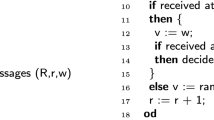Abstract
This paper considers the self-stabilizing unison problem in uniform distributed systems. The contribution of this paper is threefold. First, we establish that when any self-stabilizing asynchronous unison protocol runs in synchronous systems, it converges to synchronous unison if the size of the clock K is greater than C G , C G being the length of the maximal cycle of the shortest maximal cycle basis if the graph contains cycles, 2 otherwise (tree networks). The second result demonstrates that the asynchronous unison in Boulinier et al. (In PODC ’04: Proceedings of the twenty-third annual ACM symposium on principles of distributed computing, pp. 150–159, 2004) provides a general self-stabilizing synchronous unison for trees which is optimal in memory space, i.e., it works with any K≥3, without any extra state, and stabilizes within 2D rounds, where D is the diameter of the network. This protocol gives a positive answer to the question whether there exists or not a general self-stabilizing synchronous unison for tree networks with a state requirement independent of local or global information of the tree. If K=3, then the stabilization time of this protocol is equal to D only, i.e., it reaches the optimal performance of Herman and Ghosh (Inf. Process. Lett. 54:259–265, 1995). The third result of this paper is a self-stabilizing unison for general synchronous systems. It requires K≥2 only, at least K+D states per process, and its stabilization time is 2D only. This is the best solution for general synchronous systems, both for the state requirement and the stabilization time.
Similar content being viewed by others
References
Arora, A., Dolev, S., Gouda, M.G.: Maintaining digital clocks in step. Parallel Process. Lett. 1, 11–18 (1991)
Berge, C.: Graphs and Hypergraphs. Elsevier Science, Amsterdam (1989)
Boulinier, C., Petit, F., Villain, V.: When graph theory helps self-stabilization. In: PODC ’04: Proceedings of the Twenty-third Annual ACM Symposium on Principles of Distributed Computing, pp. 150–159 (2004)
Cantarell, S., Datta, A.K., Petit, F.: Self-stabilizing atomicity refinement allowing neighborhood concurrency. In: DSN SSS’03 Workshop: 6th Symposium on Self-Stabilizing Systems (SSS ’03). Lecture Notes in Computer Science, vol. 2704, pp. 102–112. Springer, New York (2003)
Couvreur, J.M., Francez, N., Gouda, M.: Asynchronous unison. In: Proceedings of the 12th IEEE International Conference on Distributed Computing Systems (ICDCS’92), pp. 486–493 (1992)
Dijkstra, E.W.: Self stabilizing systems in spite of distributed control. Commun. Assoc. Comput. Mach. 17, 643–644 (1974)
Dolev, S.: Self-Stabilization. The MIT Press, Cambridge (2000)
Gouda, M.G., Herman, T.: Stabilizing unison. Inf. Process. Lett. 35, 171–175 (1990)
Herman, T., Ghosh, S.: Stabilizing phase-clocks. Inf. Process. Lett. 54, 259–265 (1995)
Kulkarni, S.S., Bolen, C., Oleszkiewicz, J., Robinson, A.: Alternators in read/write atomicity. Inf. Process. Lett. 93(5), 207–215 (2005)
Misra, J.: Phase synchronization. Inf. Process. Lett. 38(2), 101–105 (1991)
Misra, J.: A Discipline of Multiprogramming-Programming Theory for Distributed Applications. Springer, New York (2001)
Nolot, F.: Self-stabilizing phase clock in distributed systems. Ph.D. thesis, LaRIA, Université de Picardie Jules Verne, Amiens, France (2002). Dissertation in French
Nolot, F., Villain, V.: Universal self-stabilizing phase clock protocol with bounded memory. In: IPCCC ’01, 20th IEEE International Performance, Computing, and Communications Conference, pp. 228–235 (2001)
Author information
Authors and Affiliations
Corresponding author
Additional information
A preliminary version of this work was presented at the 7th International Symposium on Self-Stabilizing Systems (SSS 2005), Barcelona, Spain, October 2005.
Rights and permissions
About this article
Cite this article
Boulinier, C., Petit, F. & Villain, V. Synchronous vs. Asynchronous Unison. Algorithmica 51, 61–80 (2008). https://doi.org/10.1007/s00453-007-9066-x
Received:
Accepted:
Published:
Issue Date:
DOI: https://doi.org/10.1007/s00453-007-9066-x




